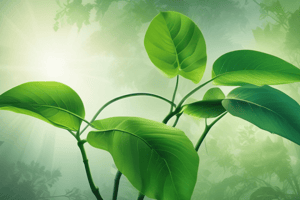Podcast
Questions and Answers
What is the first step in the break-down of glucose?
What is the first step in the break-down of glucose?
- Release of energy in the aerobic process
- Break-down of pyruvate using oxygen in the mitochondria
- Conversion of pyruvate into ethanol and carbon dioxide
- Break-down of glucose into a three-carbon molecule called pyruvate (correct)
Where does the break-down of pyruvate using oxygen take place?
Where does the break-down of pyruvate using oxygen take place?
- Mitochondria (correct)
- Nucleus
- Cytoplasm
- Cell membrane
What is the by-product of anaerobic respiration in yeast?
What is the by-product of anaerobic respiration in yeast?
- Lactic acid
- Ethanol and carbon dioxide (correct)
- Glucose
- Water
What happens when there is a lack of oxygen in muscle cells?
What happens when there is a lack of oxygen in muscle cells?
What is the end product of aerobic respiration?
What is the end product of aerobic respiration?
How many carbon atoms are in a pyruvate molecule?
How many carbon atoms are in a pyruvate molecule?
What is the term given to the process that takes place in the absence of air (oxygen)?
What is the term given to the process that takes place in the absence of air (oxygen)?
What is the difference between aerobic and anaerobic respiration?
What is the difference between aerobic and anaerobic respiration?
Why is the plant kept in a dark room for three days?
Why is the plant kept in a dark room for three days?
What happens to the colour of the leaf when it is dipped in boiling water and then alcohol?
What happens to the colour of the leaf when it is dipped in boiling water and then alcohol?
What is the purpose of dipping the leaf in a dilute solution of iodine?
What is the purpose of dipping the leaf in a dilute solution of iodine?
What can be concluded about the presence of starch in various areas of the leaf?
What can be concluded about the presence of starch in various areas of the leaf?
What is the primary function of stomata in leaves?
What is the primary function of stomata in leaves?
Why do plants close their stomata when they do not need carbon dioxide for photosynthesis?
Why do plants close their stomata when they do not need carbon dioxide for photosynthesis?
What is true about the exchange of gases in plants?
What is true about the exchange of gases in plants?
What is the purpose of tracing the green areas of the leaf on a sheet of paper?
What is the purpose of tracing the green areas of the leaf on a sheet of paper?
What is a common evidence people think of to determine if something is alive?
What is a common evidence people think of to determine if something is alive?
What is a characteristic of living organisms?
What is a characteristic of living organisms?
Why do living organisms tend to break down over time?
Why do living organisms tend to break down over time?
What is a reason why there is a controversy about whether viruses are truly alive?
What is a reason why there is a controversy about whether viruses are truly alive?
What is necessary for life, according to professional biologists?
What is necessary for life, according to professional biologists?
What can be seen in plants that are alive?
What can be seen in plants that are alive?
Why is it not enough to use visible movement as the defining characteristic of life?
Why is it not enough to use visible movement as the defining characteristic of life?
What is true about the organisation of living structures?
What is true about the organisation of living structures?
What is the main function of the villi in the small intestine?
What is the main function of the villi in the small intestine?
What happens to the unabsorbed food in the small intestine?
What happens to the unabsorbed food in the small intestine?
What is the cause of dental caries or tooth decay?
What is the cause of dental caries or tooth decay?
What is the role of saliva in preventing dental caries?
What is the role of saliva in preventing dental caries?
What is the purpose of brushing teeth after eating?
What is the purpose of brushing teeth after eating?
What happens if dental caries is left untreated?
What happens if dental caries is left untreated?
What is the function of the anal sphincter?
What is the function of the anal sphincter?
What is the role of the blood vessels in the villi?
What is the role of the blood vessels in the villi?
What is the function of the urinary bladder?
What is the function of the urinary bladder?
What happens when the urinary bladder is expanded?
What happens when the urinary bladder is expanded?
What is the function of the urethra?
What is the function of the urethra?
Why are kidneys vital organs for survival?
Why are kidneys vital organs for survival?
What happens when there is restricted blood flow to the kidneys?
What happens when there is restricted blood flow to the kidneys?
What is the purpose of an artificial kidney?
What is the purpose of an artificial kidney?
What is the characteristic of the dialysing fluid used in an artificial kidney?
What is the characteristic of the dialysing fluid used in an artificial kidney?
What is the function of the tubes in an artificial kidney?
What is the function of the tubes in an artificial kidney?
Flashcards are hidden until you start studying
Study Notes
Photosynthesis
- To demonstrate photosynthesis, keep a plant in a dark room for three days to use up starch, then keep it in sunlight for six hours.
- Pluck a leaf, mark the green areas, and trace them on paper.
- Dip the leaf in boiling water, then in a beaker containing alcohol, and heat until the alcohol boils.
- Observe the color change of the leaf and the solution.
- Dip the leaf in a dilute solution of iodine to test for starch.
- Compare the color of the leaf with the tracing done earlier to conclude about starch presence in various areas.
Stomata
- Stomata are tiny pores on the surface of leaves where massive amounts of gaseous exchange take place for photosynthesis.
- Gaseous exchange occurs across the surface of stems, roots, and leaves as well.
- Plants close stomata when they don't need carbon dioxide for photosynthesis to prevent water loss.
Life Processes
- Living organisms are well-organized structures that can break down over time due to environmental effects.
- Molecular movements are necessary for life to maintain order and organization.
- Viruses do not show molecular movement, which is why there is controversy about whether they are truly alive.
Nutrition
- Autotrophic nutrition and heterotrophic nutrition are two different types of nutrition.
- Plants obtain raw materials for photosynthesis from air, water, and soil.
Respiration
- Respiration breaks down glucose into carbon dioxide and water, releasing energy.
- Anaerobic respiration occurs in the absence of oxygen and produces ethanol and carbon dioxide.
- Aerobic respiration occurs in the presence of oxygen and produces water and more energy.
- Lactic acid builds up in muscles during sudden activity, causing cramps.
Excretory System
- Urine is stored in the urinary bladder until the pressure leads to the urge to pass it out through the urethra.
- The bladder is muscular, so it is under nervous control, allowing us to control the urge to urinate.
- Kidneys filter out nitrogenous waste products from the blood.
- Artificial kidneys can be used in case of kidney failure to remove waste products through dialysis.
Studying That Suits You
Use AI to generate personalized quizzes and flashcards to suit your learning preferences.





